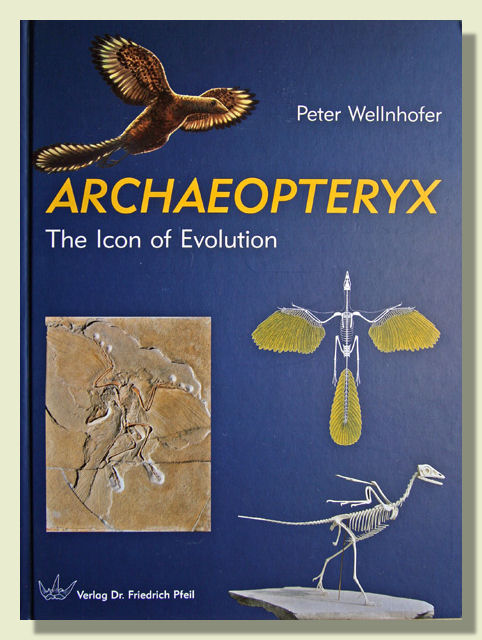Archaeopteryx: the Icon of Evolution
by Peter Wellnhofer. Pfeil Verlag, Munich, 2009, ISBN 987-3-89937-108-6. Hardcover, 208 pp., 58 Euro (about $78)
PFEIL-VERLAG

I love Archaeopteryx; to me that fossil is one of the most fascinating in the world, being the oldest bird discovered so far. It has archaic anatomical characteristics related to reptiles (primitively constructed skull, toothed jaws, movable claws on the tips of the fingers in the wings, long tail) but it also shows one feature which classifies it as a primeval bird: it has feathers, clearly visible on each of the ten specimens.
To celebrate the special exhibit held during the 2009 Munich Show, Pfeil Verlag has (finally!) presented the English edition of the revised book Archaeopteryx: the Icon of Evolution by Peter Wellnhofer.
Wellnhofer, director of the Paleontology and Geology State Museum in Munich, is the foremost authority on Archaeopteryx, having published dozens of studies about it. This book is the culmination of years of study. It starts with an historic overview of the Bavarian town of Solnhofen, where the famous fossils come from, and then it shows an extensive collection of the Solnhofen fauna and flora from the Upper Jurassic sea: there was an incredible variety of vertebrates, invertebrates, and plants living in the open sea, on the muddy bottom, in the coral reefs and on the nearby land.
Archaeopteryx is without a doubt the most famous fossil from the Solnhofen limestone. So far, no fossil vertebrate older than Archaeopteryx from the Upper Jurassic has been found that could be identified as a bird. During the last 150 years, just ten skeletons and one single feather have been discovered.
The book focuses on each of the ten specimens, including detailed descriptions and illustrations (photos, drawings, x-rays, maps), an amount of information never published before in a single source. Each Archaeopteryx has its personal story to tell, from its finder to the final display in the museum. Peter Wellnhofer has followed all of them back to the past two centuries, reconstructing all the pieces of the stories better than a CSI detective. The book is easy to read, written for the general public, even when it faces more specific and scientific topics. A big part of the book focuses on the animal Archeopteryx, describing its skeleton, plumage, physiology, lifestyle and a reconstruction of the primeval bird-including its appearance in life in a natural attitude, habits, and mode of living.
The first Archaeopteryx specimen discovered was very important in the evolutionary debate, regarded as the "missing link" between reptiles and birds. Today there is a general consensus that birds and dinosaurs are related; anyway the scientific discussion focuses on the question of whether birds are directly derived from specialized theropods or if they share a common ancestor with dinosaurs. In the book Wellnhofer analyzes many hypotheses, concluding that Archeopteryx indicates the existence of a common ancestor, a theropod that lived earlier than the Upper Jurassic, and that gaps in the fossil record still prevent our naming a particular candidate.
The last chapters of the book discuss the evolution of avian flight and fossil birds, relating Archaeopteryx to the new feathered dinosaurs from the Lower Cretaceous discovered in China in the last few years.
I am sure that Archaeopteryx: the Icon of Evolution will have a special place on your bookshelf!
Diana Fattori ©
This article was published in Fossil News April 2010.